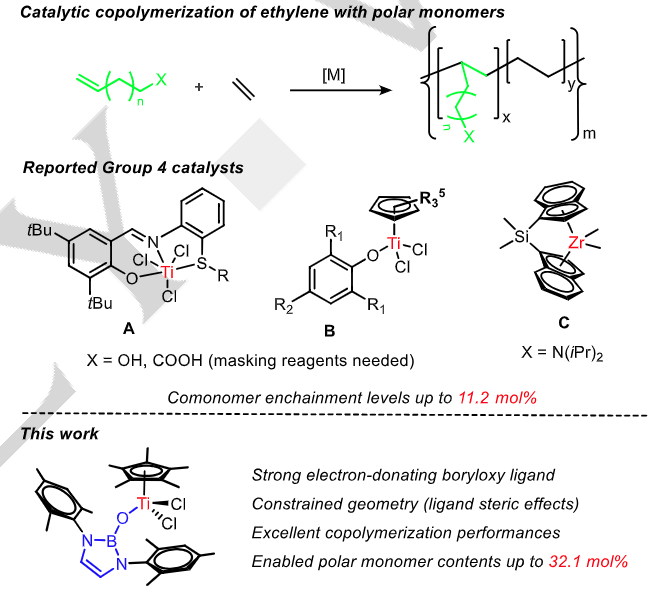Functionalized polyolefins have wide applications because of their improved surface properties, dyeability, water absorption and compatibility with other polar polymers. Post modification and free radical polymerization represent widely used strategies for the preparation of functionalized polymers. In recent years, metal-catalyzed coordination-insertion copolymerization of ethylene with polar monomers has drawn a great deal attention as it allowed the precise controlling microstructures of copolymers under relatively mild conditions. Polar monomer contents are decisive to the desirable properties of functionalized vinyl polymers. Achieving controlled high comonomer insertion places stringent demands on metal catalysts. Recently, inspired progresses in the direct copolymerization of ethylene with some simple polar monomers, such as methyl acrylates, have been made with nickel and palladium catalysts supported by phosphine-sulfonate and α-diimine ligands. However, there are also some limitations for these catalysts need to be addressed, such as modest catalytic activity and thermal stability. Owing to high activity, cost-effectiveness and ability to produce polyolefins with high molecular weights, polymerization catalysts with group 4 metal complexes have been extensively studied. In particular, copolymerization reactions of ethylene and α-olefins with the catalysts led to controlled synthesis of copolymers with diverse microstructures. Remarkably, they have also been employed as catalysts for copolymerization of ethylene withα-olefins functionalized with hydroxyl, amino, carboxylic acid and ester groups. However, the functionalized polar monomers with protic groups have to be protected in the polymerization processes because of the high Lewis acidity of the early transition metal ions. Notable work by the groups of Tang and Nomura demonstrated that tridentate [ONS] and non-bridged half-sandwich titanium complexes catalyzed the copolymerization reactions, leading to the synthesis of copolymers with hydroxyl-functionalized α-olefin incorporations up to 11.2 and 7.4% (Scheme 1, A and B), respectively. Additionally, the group of Marks reported the copolymerization of ethylene and amino-functionalized olefins, attaining the comonomer enchainment levels up to 5.5 mol% (Scheme 1, C). Unfortunately, the pronounced reduction of catalytic activities and molecular weights commonly occurred with these catalysts when striving to produce copolymers with a substantial content of polar α-olefins even in the presence of masking reagents. Consequently, the development of highly efficient group 4 catalysts which couldresult in polar functionalized polyolefin elastomers (p-POE) with high polar α-olefin enchainment remained a great challenge.
Recently, Chunming Cui’s group have synthesized half-titanocenes 1-6 ligated by strong σ electron-donating N-heterocyclic boryloxy ligands. Complexes 2 and 5 bearing bulky Cp* and the boryloxy ligands adopt a constrained structure because of the steric repulsions between the two ligands. The combination of the strong electron-donating property and steric hindrance of the N-heterocyclic boryloxy ligands are responsible for the high activity, thermal stability and tolerance to pacified hydroxyl groups, leading to the formation of high molecular weight polyolefins with high comonomer contents. Notably, complex 5 achieved an unprecedentedly high polar α-olefin enchainment (up to 32.1mol%) while maintaining a high catalytic activity (up to 3.04 × 108g polymer·mol−1(Ti)·h−1). The copolymers exhibited impressive strength and toughness, owing to the presence of hydrogen bonds. Further investigations on the electronic effects of N-heterocyclic boryloxy ligands on the properties of the resulting metal complexes are still undertaken in their laboratory. Relevant achievements were published in Angew. Chem. Int. Ed., 2024, DOI: 10.1002/anie.202414464.

Scheme. Copolymerization of ethylene and polar functionalized α-olefins by group 4 metal catalysts